Research Method Assignment: Ethical Dilemma, Portfolio, and Analysis
VerifiedAdded on 2020/03/04
|24
|4987
|201
Report
AI Summary
This report presents a comprehensive analysis of research methods, focusing on an ethical dilemma faced by a research manager and an employee satisfaction portfolio. The first part of the assignment delves into an ethical dilemma concerning a research manager tasked with investigating employee job dissatisfaction under an autocratic leader. The manager grapples with conflicting directives from the managing director, who demands access to individual employee responses, raising ethical concerns about confidentiality and fairness. The report explores various ethical considerations, including the manager's options and the potential impact of different courses of action. The second part of the assignment involves a portfolio analysis of employee satisfaction data collected through a survey. The analysis utilizes descriptive statistical techniques to examine employee demographics, job roles, and opinions on various aspects of their work experience. Key findings include the distribution of employee tenure, job grades, and ages, as well as employee perceptions regarding accomplishments and feeling valued within the company. The report includes histograms to visualize the distribution of opinions for survey questions. The report concludes with a discussion of the ethical considerations in research and practical applications of the findings.
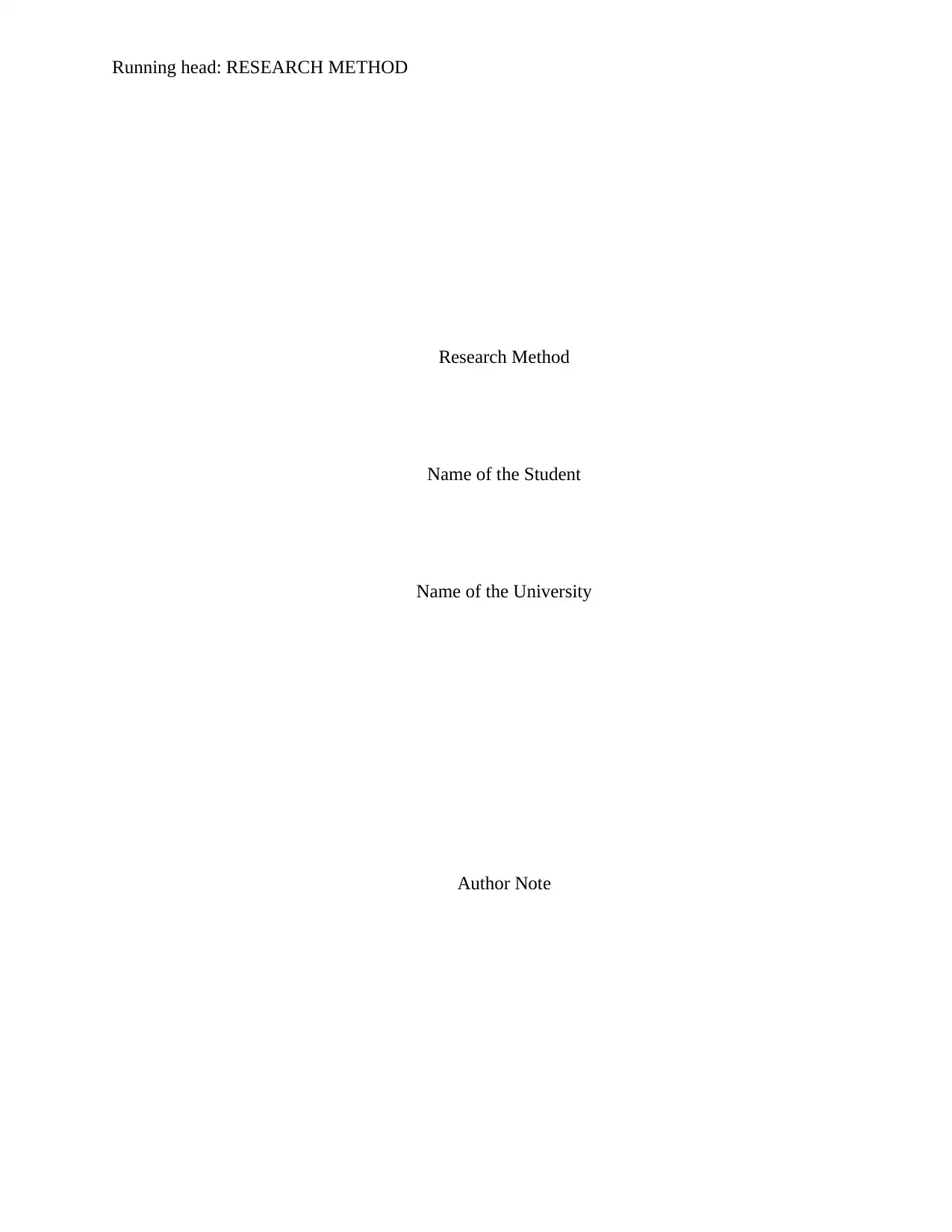
Running head: RESEARCH METHOD
Research Method
Name of the Student
Name of the University
Author Note
Research Method
Name of the Student
Name of the University
Author Note
Paraphrase This Document
Need a fresh take? Get an instant paraphrase of this document with our AI Paraphraser
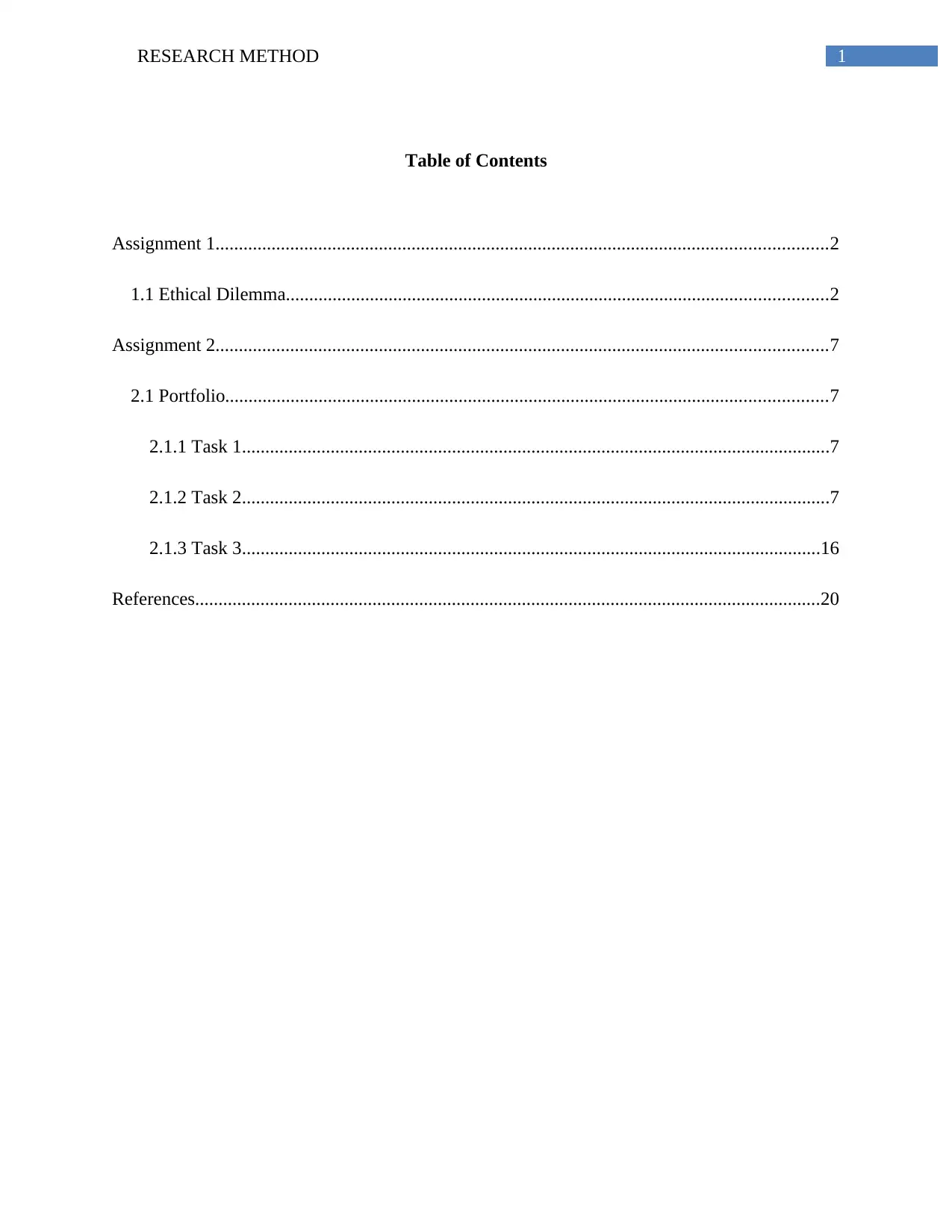
1RESEARCH METHOD
Table of Contents
Assignment 1...................................................................................................................................2
1.1 Ethical Dilemma....................................................................................................................2
Assignment 2...................................................................................................................................7
2.1 Portfolio.................................................................................................................................7
2.1.1 Task 1..............................................................................................................................7
2.1.2 Task 2..............................................................................................................................7
2.1.3 Task 3............................................................................................................................16
References......................................................................................................................................20
Table of Contents
Assignment 1...................................................................................................................................2
1.1 Ethical Dilemma....................................................................................................................2
Assignment 2...................................................................................................................................7
2.1 Portfolio.................................................................................................................................7
2.1.1 Task 1..............................................................................................................................7
2.1.2 Task 2..............................................................................................................................7
2.1.3 Task 3............................................................................................................................16
References......................................................................................................................................20
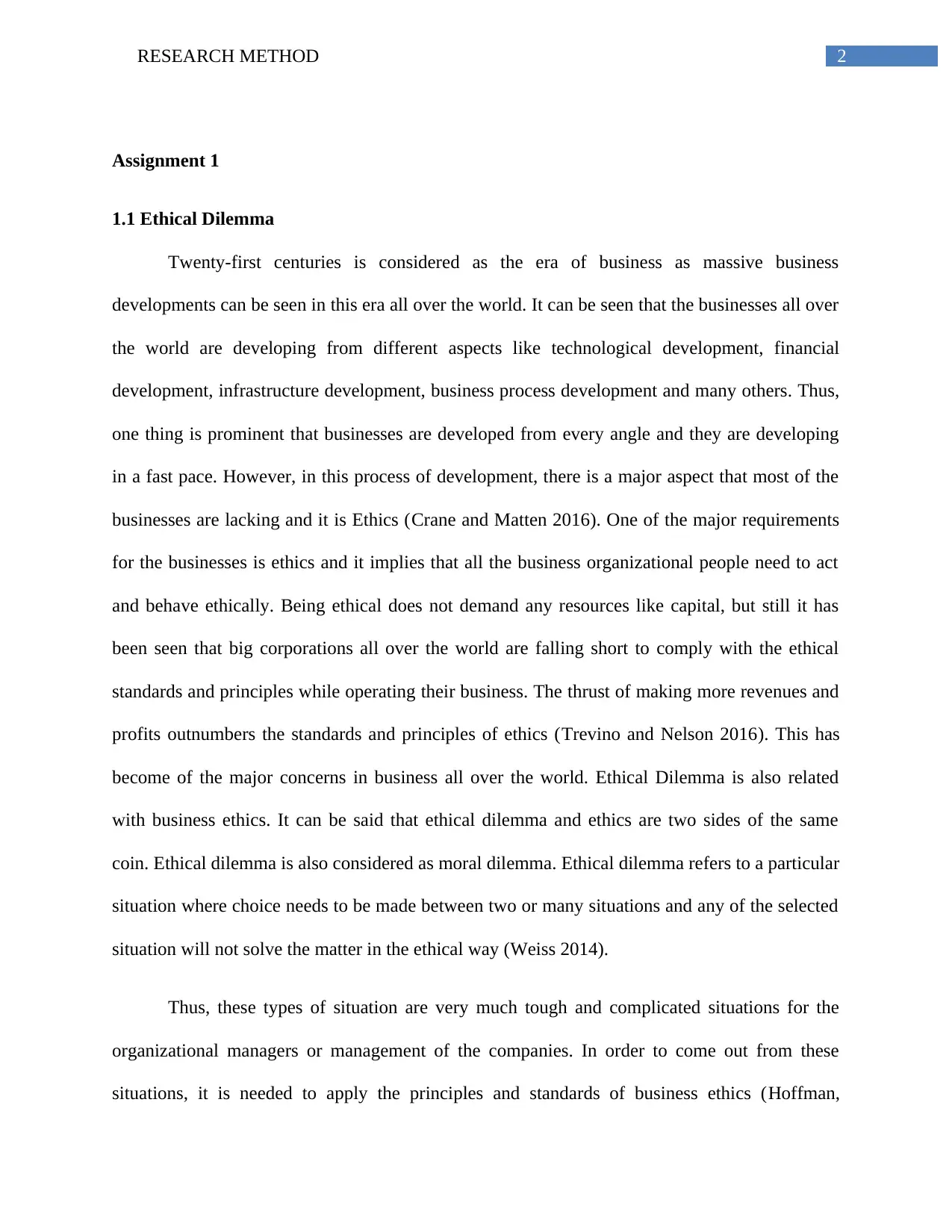
2RESEARCH METHOD
Assignment 1
1.1 Ethical Dilemma
Twenty-first centuries is considered as the era of business as massive business
developments can be seen in this era all over the world. It can be seen that the businesses all over
the world are developing from different aspects like technological development, financial
development, infrastructure development, business process development and many others. Thus,
one thing is prominent that businesses are developed from every angle and they are developing
in a fast pace. However, in this process of development, there is a major aspect that most of the
businesses are lacking and it is Ethics (Crane and Matten 2016). One of the major requirements
for the businesses is ethics and it implies that all the business organizational people need to act
and behave ethically. Being ethical does not demand any resources like capital, but still it has
been seen that big corporations all over the world are falling short to comply with the ethical
standards and principles while operating their business. The thrust of making more revenues and
profits outnumbers the standards and principles of ethics (Trevino and Nelson 2016). This has
become of the major concerns in business all over the world. Ethical Dilemma is also related
with business ethics. It can be said that ethical dilemma and ethics are two sides of the same
coin. Ethical dilemma is also considered as moral dilemma. Ethical dilemma refers to a particular
situation where choice needs to be made between two or many situations and any of the selected
situation will not solve the matter in the ethical way (Weiss 2014).
Thus, these types of situation are very much tough and complicated situations for the
organizational managers or management of the companies. In order to come out from these
situations, it is needed to apply the principles and standards of business ethics (Hoffman,
Assignment 1
1.1 Ethical Dilemma
Twenty-first centuries is considered as the era of business as massive business
developments can be seen in this era all over the world. It can be seen that the businesses all over
the world are developing from different aspects like technological development, financial
development, infrastructure development, business process development and many others. Thus,
one thing is prominent that businesses are developed from every angle and they are developing
in a fast pace. However, in this process of development, there is a major aspect that most of the
businesses are lacking and it is Ethics (Crane and Matten 2016). One of the major requirements
for the businesses is ethics and it implies that all the business organizational people need to act
and behave ethically. Being ethical does not demand any resources like capital, but still it has
been seen that big corporations all over the world are falling short to comply with the ethical
standards and principles while operating their business. The thrust of making more revenues and
profits outnumbers the standards and principles of ethics (Trevino and Nelson 2016). This has
become of the major concerns in business all over the world. Ethical Dilemma is also related
with business ethics. It can be said that ethical dilemma and ethics are two sides of the same
coin. Ethical dilemma is also considered as moral dilemma. Ethical dilemma refers to a particular
situation where choice needs to be made between two or many situations and any of the selected
situation will not solve the matter in the ethical way (Weiss 2014).
Thus, these types of situation are very much tough and complicated situations for the
organizational managers or management of the companies. In order to come out from these
situations, it is needed to apply the principles and standards of business ethics (Hoffman,
⊘ This is a preview!⊘
Do you want full access?
Subscribe today to unlock all pages.

Trusted by 1+ million students worldwide
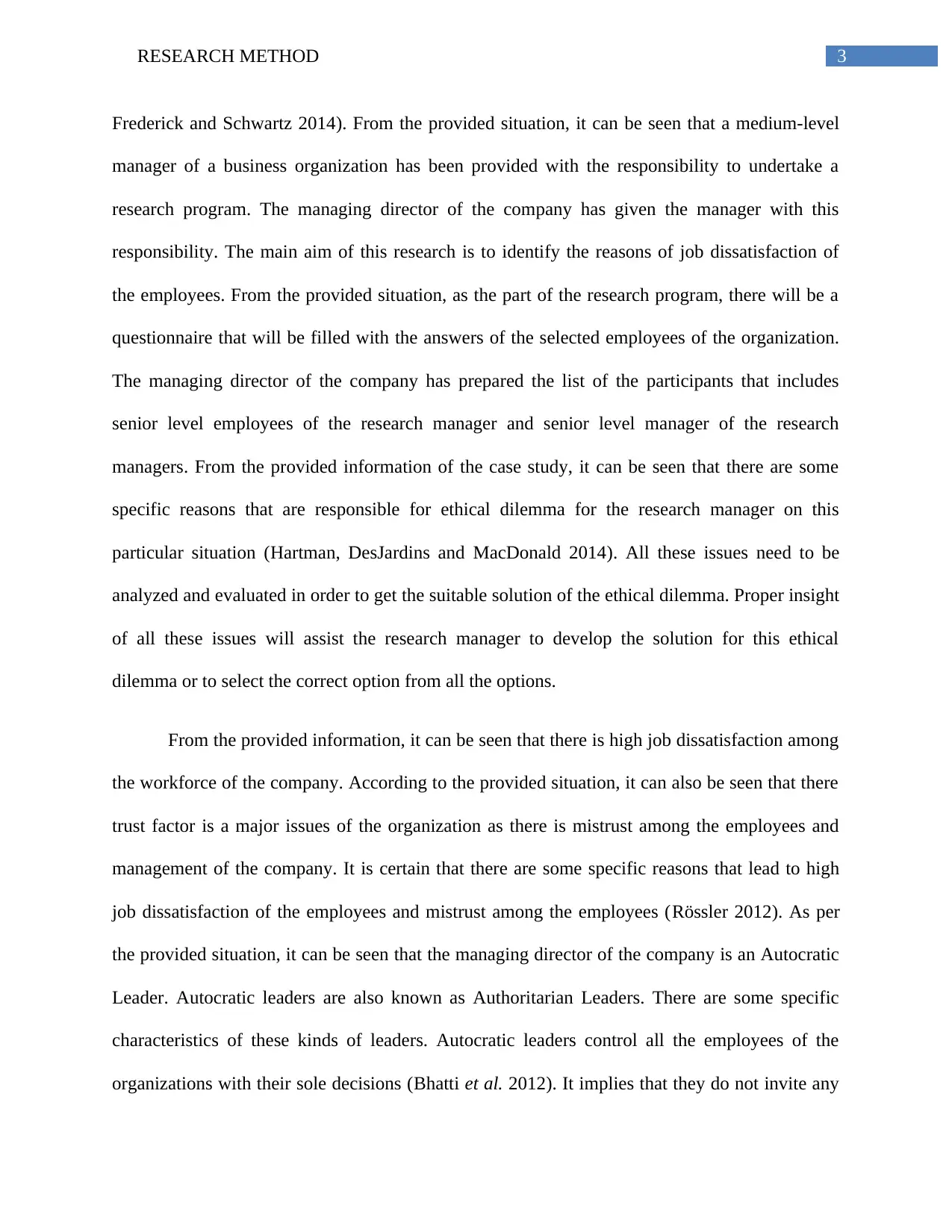
3RESEARCH METHOD
Frederick and Schwartz 2014). From the provided situation, it can be seen that a medium-level
manager of a business organization has been provided with the responsibility to undertake a
research program. The managing director of the company has given the manager with this
responsibility. The main aim of this research is to identify the reasons of job dissatisfaction of
the employees. From the provided situation, as the part of the research program, there will be a
questionnaire that will be filled with the answers of the selected employees of the organization.
The managing director of the company has prepared the list of the participants that includes
senior level employees of the research manager and senior level manager of the research
managers. From the provided information of the case study, it can be seen that there are some
specific reasons that are responsible for ethical dilemma for the research manager on this
particular situation (Hartman, DesJardins and MacDonald 2014). All these issues need to be
analyzed and evaluated in order to get the suitable solution of the ethical dilemma. Proper insight
of all these issues will assist the research manager to develop the solution for this ethical
dilemma or to select the correct option from all the options.
From the provided information, it can be seen that there is high job dissatisfaction among
the workforce of the company. According to the provided situation, it can also be seen that there
trust factor is a major issues of the organization as there is mistrust among the employees and
management of the company. It is certain that there are some specific reasons that lead to high
job dissatisfaction of the employees and mistrust among the employees (Rössler 2012). As per
the provided situation, it can be seen that the managing director of the company is an Autocratic
Leader. Autocratic leaders are also known as Authoritarian Leaders. There are some specific
characteristics of these kinds of leaders. Autocratic leaders control all the employees of the
organizations with their sole decisions (Bhatti et al. 2012). It implies that they do not invite any
Frederick and Schwartz 2014). From the provided situation, it can be seen that a medium-level
manager of a business organization has been provided with the responsibility to undertake a
research program. The managing director of the company has given the manager with this
responsibility. The main aim of this research is to identify the reasons of job dissatisfaction of
the employees. From the provided situation, as the part of the research program, there will be a
questionnaire that will be filled with the answers of the selected employees of the organization.
The managing director of the company has prepared the list of the participants that includes
senior level employees of the research manager and senior level manager of the research
managers. From the provided information of the case study, it can be seen that there are some
specific reasons that are responsible for ethical dilemma for the research manager on this
particular situation (Hartman, DesJardins and MacDonald 2014). All these issues need to be
analyzed and evaluated in order to get the suitable solution of the ethical dilemma. Proper insight
of all these issues will assist the research manager to develop the solution for this ethical
dilemma or to select the correct option from all the options.
From the provided information, it can be seen that there is high job dissatisfaction among
the workforce of the company. According to the provided situation, it can also be seen that there
trust factor is a major issues of the organization as there is mistrust among the employees and
management of the company. It is certain that there are some specific reasons that lead to high
job dissatisfaction of the employees and mistrust among the employees (Rössler 2012). As per
the provided situation, it can be seen that the managing director of the company is an Autocratic
Leader. Autocratic leaders are also known as Authoritarian Leaders. There are some specific
characteristics of these kinds of leaders. Autocratic leaders control all the employees of the
organizations with their sole decisions (Bhatti et al. 2012). It implies that they do not invite any
Paraphrase This Document
Need a fresh take? Get an instant paraphrase of this document with our AI Paraphraser
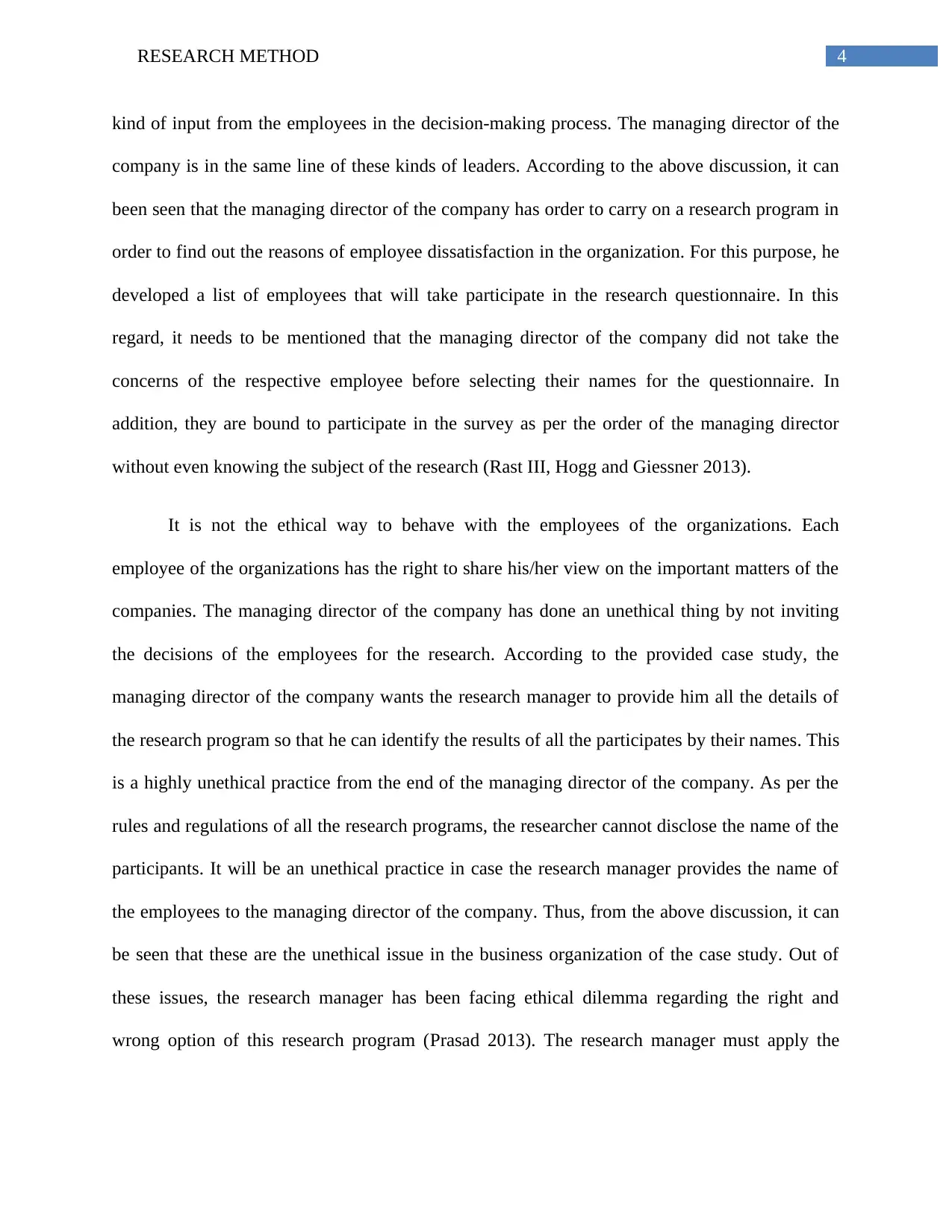
4RESEARCH METHOD
kind of input from the employees in the decision-making process. The managing director of the
company is in the same line of these kinds of leaders. According to the above discussion, it can
been seen that the managing director of the company has order to carry on a research program in
order to find out the reasons of employee dissatisfaction in the organization. For this purpose, he
developed a list of employees that will take participate in the research questionnaire. In this
regard, it needs to be mentioned that the managing director of the company did not take the
concerns of the respective employee before selecting their names for the questionnaire. In
addition, they are bound to participate in the survey as per the order of the managing director
without even knowing the subject of the research (Rast III, Hogg and Giessner 2013).
It is not the ethical way to behave with the employees of the organizations. Each
employee of the organizations has the right to share his/her view on the important matters of the
companies. The managing director of the company has done an unethical thing by not inviting
the decisions of the employees for the research. According to the provided case study, the
managing director of the company wants the research manager to provide him all the details of
the research program so that he can identify the results of all the participates by their names. This
is a highly unethical practice from the end of the managing director of the company. As per the
rules and regulations of all the research programs, the researcher cannot disclose the name of the
participants. It will be an unethical practice in case the research manager provides the name of
the employees to the managing director of the company. Thus, from the above discussion, it can
be seen that these are the unethical issue in the business organization of the case study. Out of
these issues, the research manager has been facing ethical dilemma regarding the right and
wrong option of this research program (Prasad 2013). The research manager must apply the
kind of input from the employees in the decision-making process. The managing director of the
company is in the same line of these kinds of leaders. According to the above discussion, it can
been seen that the managing director of the company has order to carry on a research program in
order to find out the reasons of employee dissatisfaction in the organization. For this purpose, he
developed a list of employees that will take participate in the research questionnaire. In this
regard, it needs to be mentioned that the managing director of the company did not take the
concerns of the respective employee before selecting their names for the questionnaire. In
addition, they are bound to participate in the survey as per the order of the managing director
without even knowing the subject of the research (Rast III, Hogg and Giessner 2013).
It is not the ethical way to behave with the employees of the organizations. Each
employee of the organizations has the right to share his/her view on the important matters of the
companies. The managing director of the company has done an unethical thing by not inviting
the decisions of the employees for the research. According to the provided case study, the
managing director of the company wants the research manager to provide him all the details of
the research program so that he can identify the results of all the participates by their names. This
is a highly unethical practice from the end of the managing director of the company. As per the
rules and regulations of all the research programs, the researcher cannot disclose the name of the
participants. It will be an unethical practice in case the research manager provides the name of
the employees to the managing director of the company. Thus, from the above discussion, it can
be seen that these are the unethical issue in the business organization of the case study. Out of
these issues, the research manager has been facing ethical dilemma regarding the right and
wrong option of this research program (Prasad 2013). The research manager must apply the
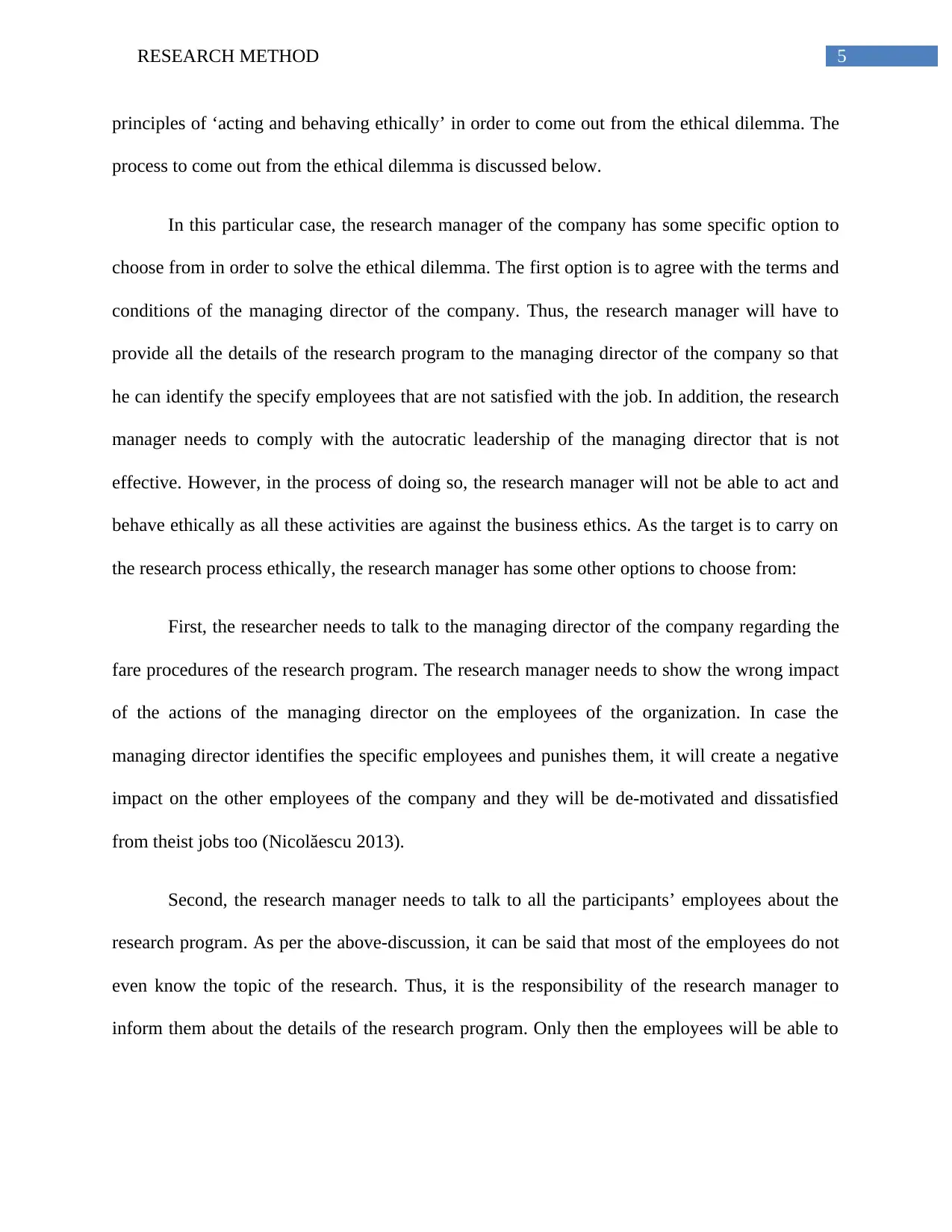
5RESEARCH METHOD
principles of ‘acting and behaving ethically’ in order to come out from the ethical dilemma. The
process to come out from the ethical dilemma is discussed below.
In this particular case, the research manager of the company has some specific option to
choose from in order to solve the ethical dilemma. The first option is to agree with the terms and
conditions of the managing director of the company. Thus, the research manager will have to
provide all the details of the research program to the managing director of the company so that
he can identify the specify employees that are not satisfied with the job. In addition, the research
manager needs to comply with the autocratic leadership of the managing director that is not
effective. However, in the process of doing so, the research manager will not be able to act and
behave ethically as all these activities are against the business ethics. As the target is to carry on
the research process ethically, the research manager has some other options to choose from:
First, the researcher needs to talk to the managing director of the company regarding the
fare procedures of the research program. The research manager needs to show the wrong impact
of the actions of the managing director on the employees of the organization. In case the
managing director identifies the specific employees and punishes them, it will create a negative
impact on the other employees of the company and they will be de-motivated and dissatisfied
from theist jobs too (Nicolăescu 2013).
Second, the research manager needs to talk to all the participants’ employees about the
research program. As per the above-discussion, it can be said that most of the employees do not
even know the topic of the research. Thus, it is the responsibility of the research manager to
inform them about the details of the research program. Only then the employees will be able to
principles of ‘acting and behaving ethically’ in order to come out from the ethical dilemma. The
process to come out from the ethical dilemma is discussed below.
In this particular case, the research manager of the company has some specific option to
choose from in order to solve the ethical dilemma. The first option is to agree with the terms and
conditions of the managing director of the company. Thus, the research manager will have to
provide all the details of the research program to the managing director of the company so that
he can identify the specify employees that are not satisfied with the job. In addition, the research
manager needs to comply with the autocratic leadership of the managing director that is not
effective. However, in the process of doing so, the research manager will not be able to act and
behave ethically as all these activities are against the business ethics. As the target is to carry on
the research process ethically, the research manager has some other options to choose from:
First, the researcher needs to talk to the managing director of the company regarding the
fare procedures of the research program. The research manager needs to show the wrong impact
of the actions of the managing director on the employees of the organization. In case the
managing director identifies the specific employees and punishes them, it will create a negative
impact on the other employees of the company and they will be de-motivated and dissatisfied
from theist jobs too (Nicolăescu 2013).
Second, the research manager needs to talk to all the participants’ employees about the
research program. As per the above-discussion, it can be said that most of the employees do not
even know the topic of the research. Thus, it is the responsibility of the research manager to
inform them about the details of the research program. Only then the employees will be able to
⊘ This is a preview!⊘
Do you want full access?
Subscribe today to unlock all pages.

Trusted by 1+ million students worldwide
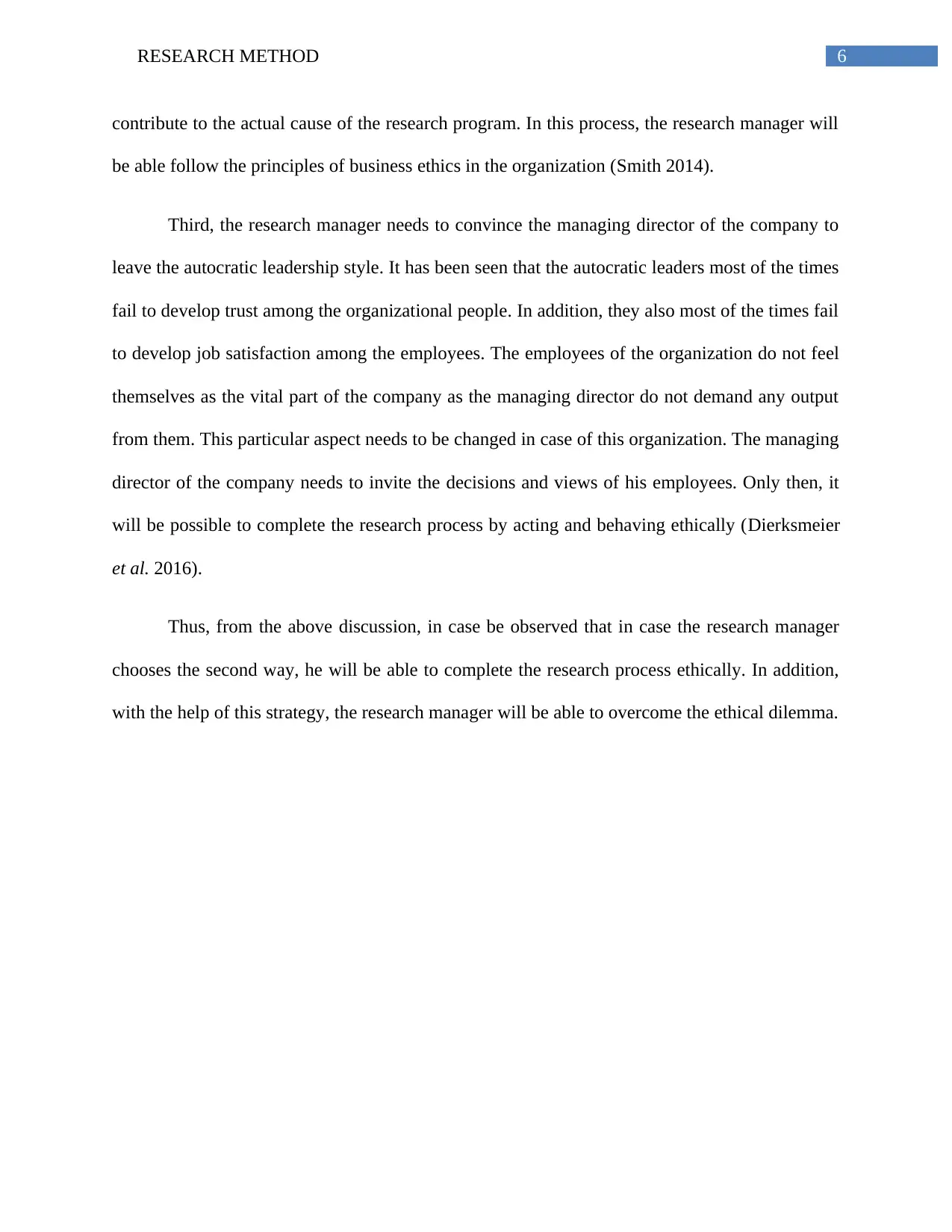
6RESEARCH METHOD
contribute to the actual cause of the research program. In this process, the research manager will
be able follow the principles of business ethics in the organization (Smith 2014).
Third, the research manager needs to convince the managing director of the company to
leave the autocratic leadership style. It has been seen that the autocratic leaders most of the times
fail to develop trust among the organizational people. In addition, they also most of the times fail
to develop job satisfaction among the employees. The employees of the organization do not feel
themselves as the vital part of the company as the managing director do not demand any output
from them. This particular aspect needs to be changed in case of this organization. The managing
director of the company needs to invite the decisions and views of his employees. Only then, it
will be possible to complete the research process by acting and behaving ethically (Dierksmeier
et al. 2016).
Thus, from the above discussion, in case be observed that in case the research manager
chooses the second way, he will be able to complete the research process ethically. In addition,
with the help of this strategy, the research manager will be able to overcome the ethical dilemma.
contribute to the actual cause of the research program. In this process, the research manager will
be able follow the principles of business ethics in the organization (Smith 2014).
Third, the research manager needs to convince the managing director of the company to
leave the autocratic leadership style. It has been seen that the autocratic leaders most of the times
fail to develop trust among the organizational people. In addition, they also most of the times fail
to develop job satisfaction among the employees. The employees of the organization do not feel
themselves as the vital part of the company as the managing director do not demand any output
from them. This particular aspect needs to be changed in case of this organization. The managing
director of the company needs to invite the decisions and views of his employees. Only then, it
will be possible to complete the research process by acting and behaving ethically (Dierksmeier
et al. 2016).
Thus, from the above discussion, in case be observed that in case the research manager
chooses the second way, he will be able to complete the research process ethically. In addition,
with the help of this strategy, the research manager will be able to overcome the ethical dilemma.
Paraphrase This Document
Need a fresh take? Get an instant paraphrase of this document with our AI Paraphraser
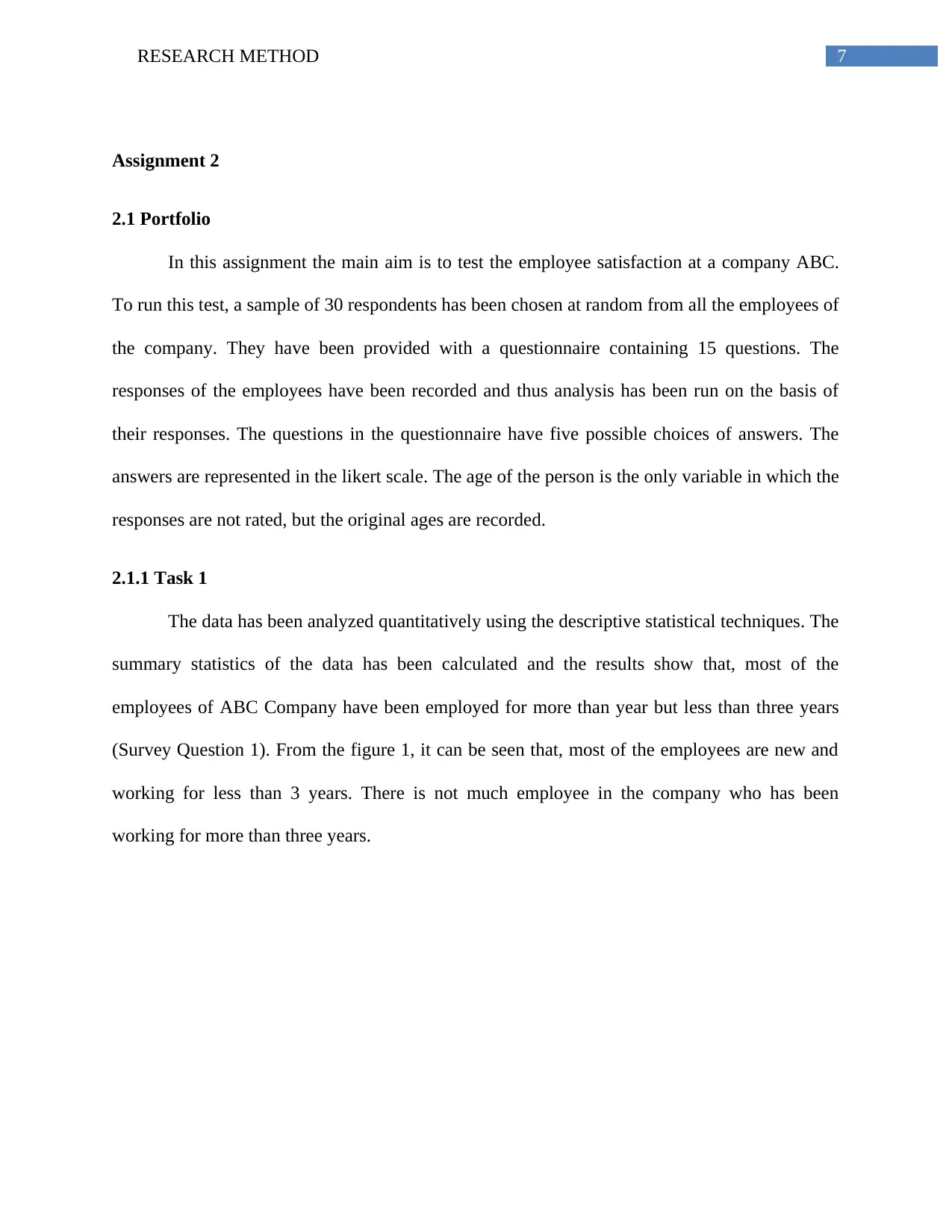
7RESEARCH METHOD
Assignment 2
2.1 Portfolio
In this assignment the main aim is to test the employee satisfaction at a company ABC.
To run this test, a sample of 30 respondents has been chosen at random from all the employees of
the company. They have been provided with a questionnaire containing 15 questions. The
responses of the employees have been recorded and thus analysis has been run on the basis of
their responses. The questions in the questionnaire have five possible choices of answers. The
answers are represented in the likert scale. The age of the person is the only variable in which the
responses are not rated, but the original ages are recorded.
2.1.1 Task 1
The data has been analyzed quantitatively using the descriptive statistical techniques. The
summary statistics of the data has been calculated and the results show that, most of the
employees of ABC Company have been employed for more than year but less than three years
(Survey Question 1). From the figure 1, it can be seen that, most of the employees are new and
working for less than 3 years. There is not much employee in the company who has been
working for more than three years.
Assignment 2
2.1 Portfolio
In this assignment the main aim is to test the employee satisfaction at a company ABC.
To run this test, a sample of 30 respondents has been chosen at random from all the employees of
the company. They have been provided with a questionnaire containing 15 questions. The
responses of the employees have been recorded and thus analysis has been run on the basis of
their responses. The questions in the questionnaire have five possible choices of answers. The
answers are represented in the likert scale. The age of the person is the only variable in which the
responses are not rated, but the original ages are recorded.
2.1.1 Task 1
The data has been analyzed quantitatively using the descriptive statistical techniques. The
summary statistics of the data has been calculated and the results show that, most of the
employees of ABC Company have been employed for more than year but less than three years
(Survey Question 1). From the figure 1, it can be seen that, most of the employees are new and
working for less than 3 years. There is not much employee in the company who has been
working for more than three years.
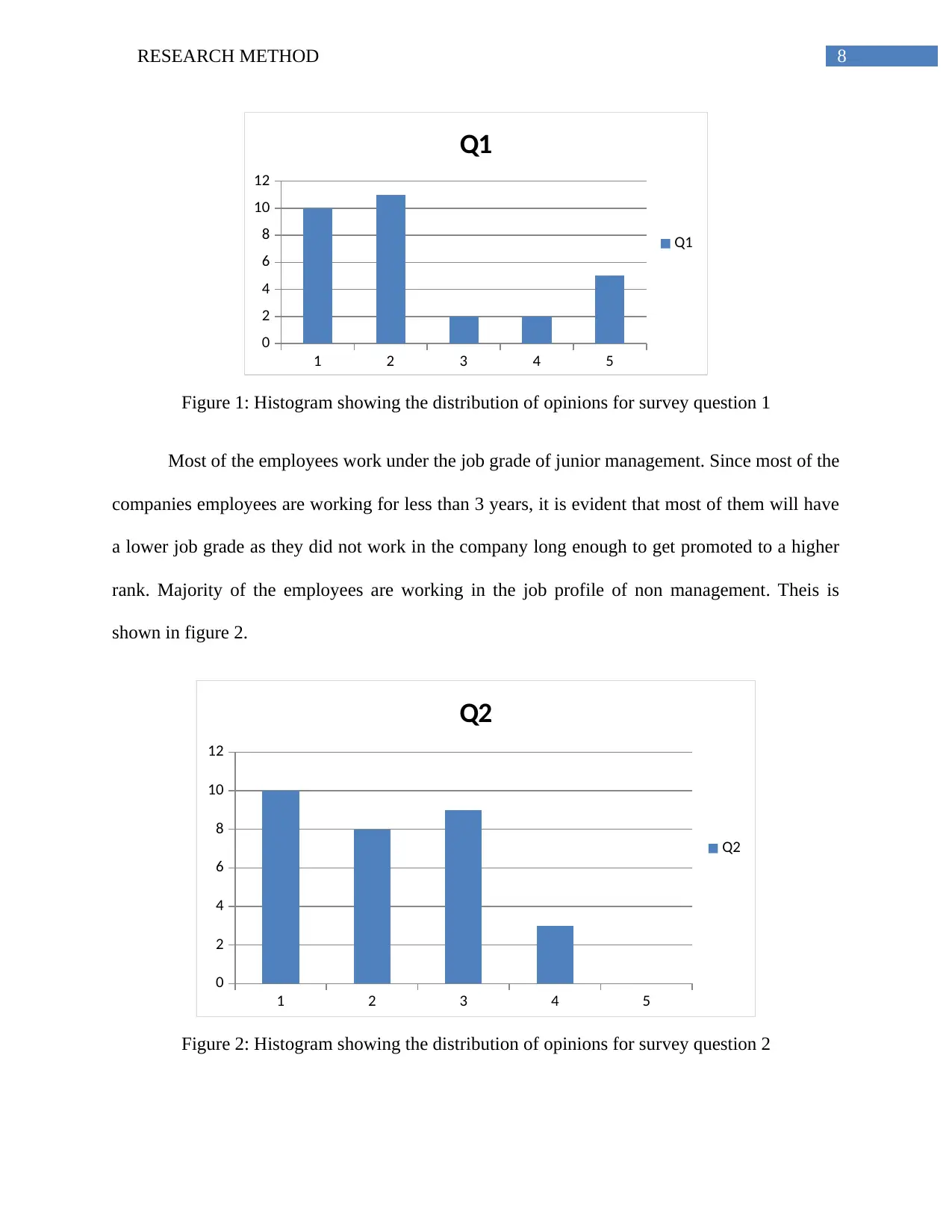
8RESEARCH METHOD
1 2 3 4 5
0
2
4
6
8
10
12
Q1
Q1
Figure 1: Histogram showing the distribution of opinions for survey question 1
Most of the employees work under the job grade of junior management. Since most of the
companies employees are working for less than 3 years, it is evident that most of them will have
a lower job grade as they did not work in the company long enough to get promoted to a higher
rank. Majority of the employees are working in the job profile of non management. Theis is
shown in figure 2.
1 2 3 4 5
0
2
4
6
8
10
12
Q2
Q2
Figure 2: Histogram showing the distribution of opinions for survey question 2
1 2 3 4 5
0
2
4
6
8
10
12
Q1
Q1
Figure 1: Histogram showing the distribution of opinions for survey question 1
Most of the employees work under the job grade of junior management. Since most of the
companies employees are working for less than 3 years, it is evident that most of them will have
a lower job grade as they did not work in the company long enough to get promoted to a higher
rank. Majority of the employees are working in the job profile of non management. Theis is
shown in figure 2.
1 2 3 4 5
0
2
4
6
8
10
12
Q2
Q2
Figure 2: Histogram showing the distribution of opinions for survey question 2
⊘ This is a preview!⊘
Do you want full access?
Subscribe today to unlock all pages.

Trusted by 1+ million students worldwide
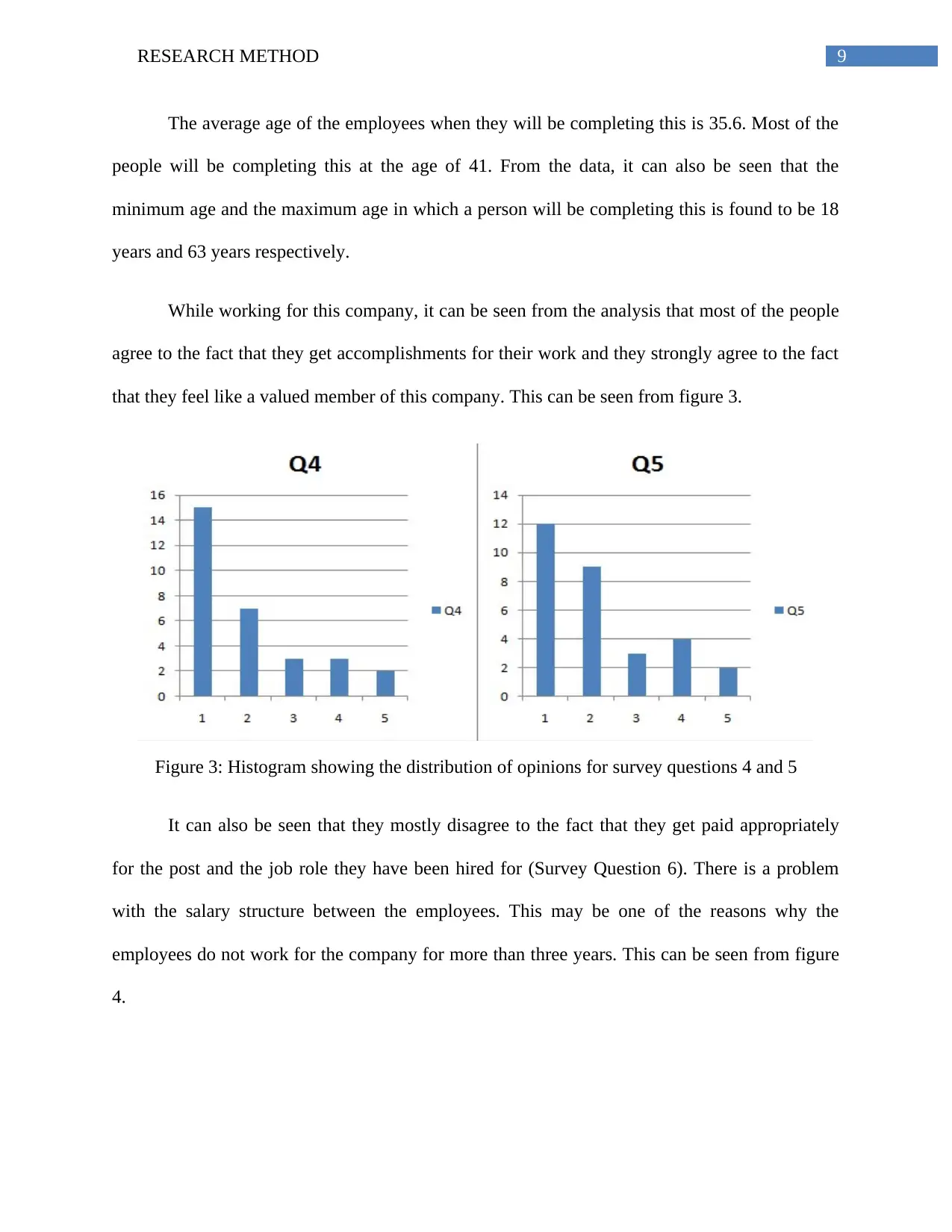
9RESEARCH METHOD
The average age of the employees when they will be completing this is 35.6. Most of the
people will be completing this at the age of 41. From the data, it can also be seen that the
minimum age and the maximum age in which a person will be completing this is found to be 18
years and 63 years respectively.
While working for this company, it can be seen from the analysis that most of the people
agree to the fact that they get accomplishments for their work and they strongly agree to the fact
that they feel like a valued member of this company. This can be seen from figure 3.
Figure 3: Histogram showing the distribution of opinions for survey questions 4 and 5
It can also be seen that they mostly disagree to the fact that they get paid appropriately
for the post and the job role they have been hired for (Survey Question 6). There is a problem
with the salary structure between the employees. This may be one of the reasons why the
employees do not work for the company for more than three years. This can be seen from figure
4.
The average age of the employees when they will be completing this is 35.6. Most of the
people will be completing this at the age of 41. From the data, it can also be seen that the
minimum age and the maximum age in which a person will be completing this is found to be 18
years and 63 years respectively.
While working for this company, it can be seen from the analysis that most of the people
agree to the fact that they get accomplishments for their work and they strongly agree to the fact
that they feel like a valued member of this company. This can be seen from figure 3.
Figure 3: Histogram showing the distribution of opinions for survey questions 4 and 5
It can also be seen that they mostly disagree to the fact that they get paid appropriately
for the post and the job role they have been hired for (Survey Question 6). There is a problem
with the salary structure between the employees. This may be one of the reasons why the
employees do not work for the company for more than three years. This can be seen from figure
4.
Paraphrase This Document
Need a fresh take? Get an instant paraphrase of this document with our AI Paraphraser
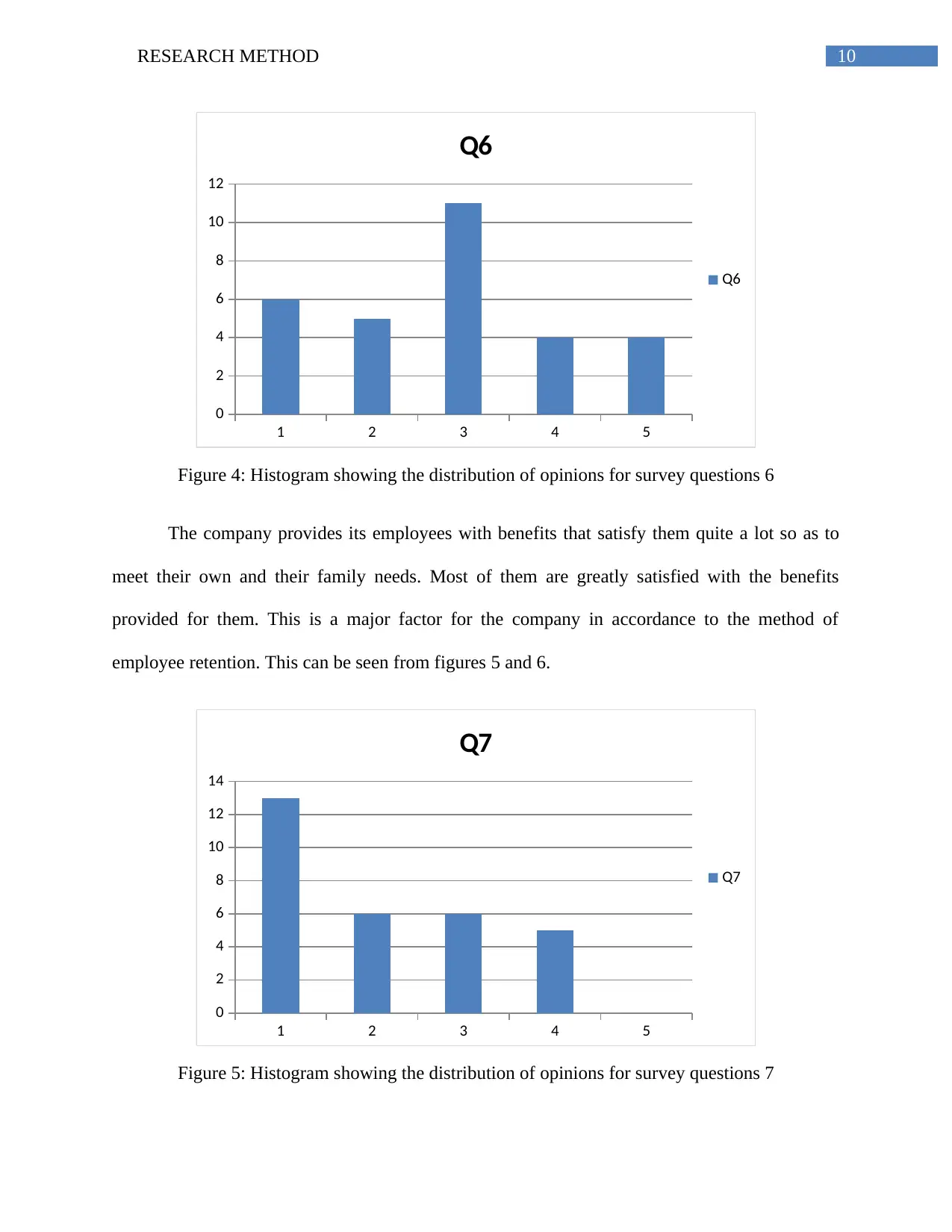
10RESEARCH METHOD
1 2 3 4 5
0
2
4
6
8
10
12
Q6
Q6
Figure 4: Histogram showing the distribution of opinions for survey questions 6
The company provides its employees with benefits that satisfy them quite a lot so as to
meet their own and their family needs. Most of them are greatly satisfied with the benefits
provided for them. This is a major factor for the company in accordance to the method of
employee retention. This can be seen from figures 5 and 6.
1 2 3 4 5
0
2
4
6
8
10
12
14
Q7
Q7
Figure 5: Histogram showing the distribution of opinions for survey questions 7
1 2 3 4 5
0
2
4
6
8
10
12
Q6
Q6
Figure 4: Histogram showing the distribution of opinions for survey questions 6
The company provides its employees with benefits that satisfy them quite a lot so as to
meet their own and their family needs. Most of them are greatly satisfied with the benefits
provided for them. This is a major factor for the company in accordance to the method of
employee retention. This can be seen from figures 5 and 6.
1 2 3 4 5
0
2
4
6
8
10
12
14
Q7
Q7
Figure 5: Histogram showing the distribution of opinions for survey questions 7
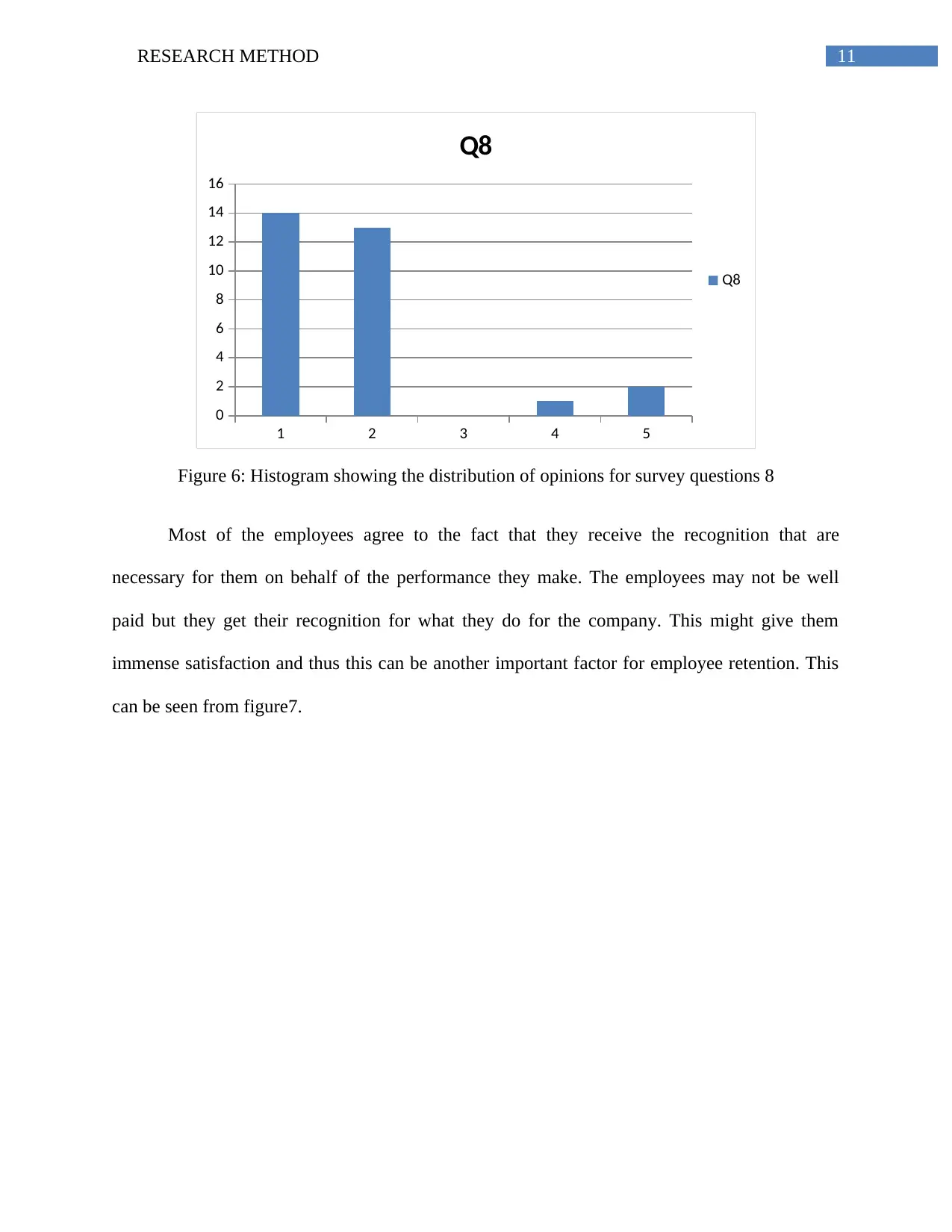
11RESEARCH METHOD
1 2 3 4 5
0
2
4
6
8
10
12
14
16
Q8
Q8
Figure 6: Histogram showing the distribution of opinions for survey questions 8
Most of the employees agree to the fact that they receive the recognition that are
necessary for them on behalf of the performance they make. The employees may not be well
paid but they get their recognition for what they do for the company. This might give them
immense satisfaction and thus this can be another important factor for employee retention. This
can be seen from figure7.
1 2 3 4 5
0
2
4
6
8
10
12
14
16
Q8
Q8
Figure 6: Histogram showing the distribution of opinions for survey questions 8
Most of the employees agree to the fact that they receive the recognition that are
necessary for them on behalf of the performance they make. The employees may not be well
paid but they get their recognition for what they do for the company. This might give them
immense satisfaction and thus this can be another important factor for employee retention. This
can be seen from figure7.
⊘ This is a preview!⊘
Do you want full access?
Subscribe today to unlock all pages.

Trusted by 1+ million students worldwide
1 out of 24
Related Documents
Your All-in-One AI-Powered Toolkit for Academic Success.
+13062052269
info@desklib.com
Available 24*7 on WhatsApp / Email
![[object Object]](/_next/static/media/star-bottom.7253800d.svg)
Unlock your academic potential
Copyright © 2020–2025 A2Z Services. All Rights Reserved. Developed and managed by ZUCOL.





